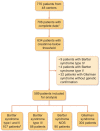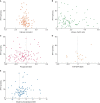Parathyroid hormone and phosphate homeostasis in patients with Bartter and Gitelman syndrome: an international cross-sectional study
- PMID: 35137195
- PMCID: PMC9681919
- DOI: 10.1093/ndt/gfac029
Parathyroid hormone and phosphate homeostasis in patients with Bartter and Gitelman syndrome: an international cross-sectional study
Abstract
Background: Small cohort studies have reported high parathyroid hormone (PTH) levels in patients with Bartter syndrome and lower serum phosphate levels have anecdotally been reported in patients with Gitelman syndrome. In this cross-sectional study, we assessed PTH and phosphate homeostasis in a large cohort of patients with salt-losing tubulopathies.
Methods: Clinical and laboratory data of 589 patients with Bartter and Gitelman syndrome were provided by members of the European Rare Kidney Diseases Reference Network (ERKNet) and the European Society for Paediatric Nephrology (ESPN).
Results: A total of 285 patients with Bartter syndrome and 304 patients with Gitelman syndrome were included for analysis. Patients with Bartter syndrome type I and II had the highest median PTH level (7.5 pmol/L) and 56% had hyperparathyroidism (PTH >7.0 pmol/L). Serum calcium was slightly lower in Bartter syndrome type I and II patients with hyperparathyroidism (2.42 versus 2.49 mmol/L; P = .038) compared to those with normal PTH levels and correlated inversely with PTH (rs -0.253; P = .009). Serum phosphate and urinary phosphate excretion did not correlate with PTH. Overall, 22% of patients had low serum phosphate levels (phosphate-standard deviation score < -2), with the highest prevalence in patients with Bartter syndrome type III (32%). Serum phosphate correlated with tubular maximum reabsorption of phosphate/glomerular filtration rate (TmP/GFR) (rs 0.699; P < .001), suggesting renal phosphate wasting.
Conclusions: Hyperparathyroidism is frequent in patients with Bartter syndrome type I and II. Low serum phosphate is observed in a significant number of patients with Bartter and Gitelman syndrome and appears associated with renal phosphate wasting.
Keywords: Bartter syndrome; Gitelman syndrome; parathyroid hormone; phosphate; salt losing tubulopathies.
© The Author(s) 2022. Published by Oxford University Press on behalf of ERA.
Figures





References
-
- Seyberth HW, Weber S, Komhoff M.. Bartter's and Gitelman's syndrome. Curr Opin Pediatr 2017; 29: 179–186 - PubMed
-
- Bettinelli A, Vigano C, Provero MCet al. . Phosphate homeostasis in Bartter syndrome: a case-control study. Pediatr Nephrol 2014; 29: 2133–2138 - PubMed
-
- Gross I, Siedner-Weintraub Y, Simckes Aet al. . Antenatal Bartter syndrome presenting as hyperparathyroidism with hypercalcemia and hypercalciuria: a case report and review. J Pediatr Endocrinol Metab 2015; 28: 943–946 - PubMed
-
- Landau D, Gurevich E, Sinai-Treiman Let al. . Accentuated hyperparathyroidism in type II Bartter syndrome. Pediatr Nephrol 2016; 31: 1085–1090 - PubMed

